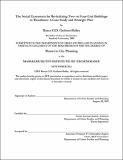The social ecosystem for revitalizing two- to four-unit buildings in Woodlawn : a case study and strategic plan
Author(s)
Graham-Bailey, Rance G. D. (Rance Gary Dubois)
DownloadFull printable version (2.297Mb)
Other Contributors
Massachusetts Institute of Technology. Department of Urban Studies and Planning.
Advisor
Karl F. Seidman.
Terms of use
Metadata
Show full item recordAbstract
The social ecosystem approach explores the individuals and organizations that help effect a particular social outcome and the factors within their environment that contribute to or hinder their success. Applied to the particular housing and community development challenge facing 2-4 unit properties in the Chicago neighborhood of Woodlawn, the standard social ecosystem model is augmented with an explicit incorporation of a development process to emphasize the importance of the entrepreneurial, financial, technical and undeniably social aspects of real estate in revitalizing urban communities. The research sets out to explore the historical causes and processes that led to vacancy and market decline; the current condition of the market and neighborhood; lessons learned from previous efforts; and the parameters of action imposed by important stakeholder interests. This analysis reveals how population loss, speculation fueled by unrealized hopes of gentrification and accumulated property-level deliquencies combine to sustain high vacancies in Woodlawn. Recent declines in homeownership, depressed property values, a shortage of local amenities and structural barriers lowering investor margins also inhibit sustainable building uses in favor of landlords who "milk" properties and target Housing Choice Voucher Recipients. Due to the lack of social capital, the neighborhood struggles to control violence and maintain the public realm. The consequence is a diminished ability to attract prospective residents despite considerable local assets. The proposed response advances five strategic outcomes: stabilization of the market; advocacy for both better policy and internal structure; expansion of loans and financial assistance for homeowners; expansion of technical assistance and counseling for homeowners; and the prioritization of local development approaches that spread benefits more equitaby than is typical of gentrification. The associated recommendations, which broadly consider policy, planning and community development, seek to create a synergy capable of addressing the challenges surfaced by the social ecosystem framework and building on existing strengths and opportunities.
Description
Thesis (M.C.P.)--Massachusetts Institute of Technology, Department of Urban Studies and Planning, 2013. Cataloged from PDF version of thesis. Includes bibliographical references (pages 132-138).
Date issued
2013Department
Massachusetts Institute of Technology. Department of Urban Studies and PlanningPublisher
Massachusetts Institute of Technology
Keywords
Urban Studies and Planning.